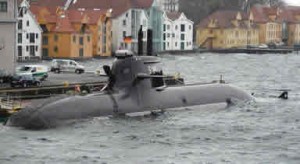Modernizing the Submarine Force
 |
| U‑212 class submarine U‑34 (S‑184) at Bremen, 2007 |
Until recently the German Navy operated a flotilla of ten submarines, based at Eckernförde. Up to 2010 the German submarine fleet consisted of modernized Type 206A diesel-electric submarines, which were originally commissioned between 1973 and 1975, and upgraded since 1992, and four new hybrid diesel-electric/fuel cell air independent propulsion (AIP) Type 212A submarines, which were commissioned between 2004 and 2006. In 2010 the remaining Type 206A subs were retired from active service as part of the Bundeswehr budget cuts. Current plans foresee a total of six Type 212A boats, with the final two vessels projected to become operational by 2012 and 2013 respectively. The original plan was to construct a total of eight Type 212 vessels, but in January 2004 the German Defense Ministry announced that no more submarines would be ordered until 2016.
Germany possesses a manufacturing capability at HDW for a diesel-electric special export-only submarine, the type 800 Dolphin class and has exported numerous variants of these, Turkey and Israel being amongst its customers. This is perceived as a very capable conventional submarine, with various shipyards offering upgrades.
The German Navy’s main roles, in conjunction with other NATO navies or as part of a UN force, are conflict prevention, crisis management, peacekeeping and counter-terrorism operations. As a result of the 212A submarine’s stealth capabilities, it is also able to carry out effective covert intelligence and reconnaissance missions. German submarines were deployed as part of peacekeeping operations in the Adriatic Sea during the mid-1990s, and as part of NATO operation “Active Endeavour” and support to the US-led conflict in Afghanistan “Enduring Freedom”.
In support of new operational priorities, there are future plans to equip the 212A with a land-attack capability. The Interactive Defense and Attack System for Submarines (IDAS), currently under development by Diehl BGT Defence, HDW and Kongsberg of Norway, uses a wire-guided missile to engage helicopters and mobile targets on shore. The third Type 212 submarine, U33 was selected as the platform for testing the new weapon. The missile made the first flight in June 2008, successfully launched from the torpedo tubes of the submerged submarine.
Mine Countermeasures Fleet
The German Navy operates five Type 352 minesweepers equipped with hull mounted DSQS-11 mine detection sonar and the ‘Troika Plus’ system, comprising a manned mothership and unmanned Seahound (seal) vessels being the lead element. Some of the older Type 333 (converted fast gun boats) are currently being retired.
The Article “The German Navy – The Way Forward?” was first published on Defense Update
 |
About the author:
Peter L. Hartley, MSc, CAET, MInstP, MIET
Peter Hartley has 41+ years experience in Defense Electronics (radar, electronic warfare, C3I, CIS and mission systems) and associated activities within UK Prime Contractors, with a depth of experience in the field of Systems including System Architecture, Bid Management and Reviews at national/international levels, Business Development and Business Creation, Customer Liaison (including 4* Military Staff and Defense Ministers), Contract Negotiation, Marketing Support, Engineering and Program Management, Design Authority, Team Building, and Research. Now an Independent Defense Consultant (http://www.creadis.co.uk), he is a Contributor to Defense Update (http://defense-update.com/), edited by Tamir Eshel.

 von
von 
